Playing Bloodborne feels familiar. I create a stone-faced player character and enter a Gothic landscape with a cursed populace. After arming myself with something sharp and heavy, I explore a city and nearby countryside from its highest steeples to its dankest depths, slaughtering hundreds of humans and beasts made twisted and feral by the curse, absorbing a precious resource from their bodies. If I reach a fire-themed checkpoint without dying, I may spend the resource to improve my character’s attributes or upgrade their weapons; if I die the resource is left where I fell and I may recover it by returning to that point, or lose it all by dying again during the attempt. I’ll need that resource and the upgrades it allows as the world’s major landmarks are guarded by super-charged monsters capable of crushing my player character in seconds.
While it has blood essence instead of souls, lanterns instead of bonfires, and a Victorian-inspired setting instead of a medieval fantasy-inspired one, there is no mistaking that Bloodborne is another entry in FromSoftware’s influential Souls series.
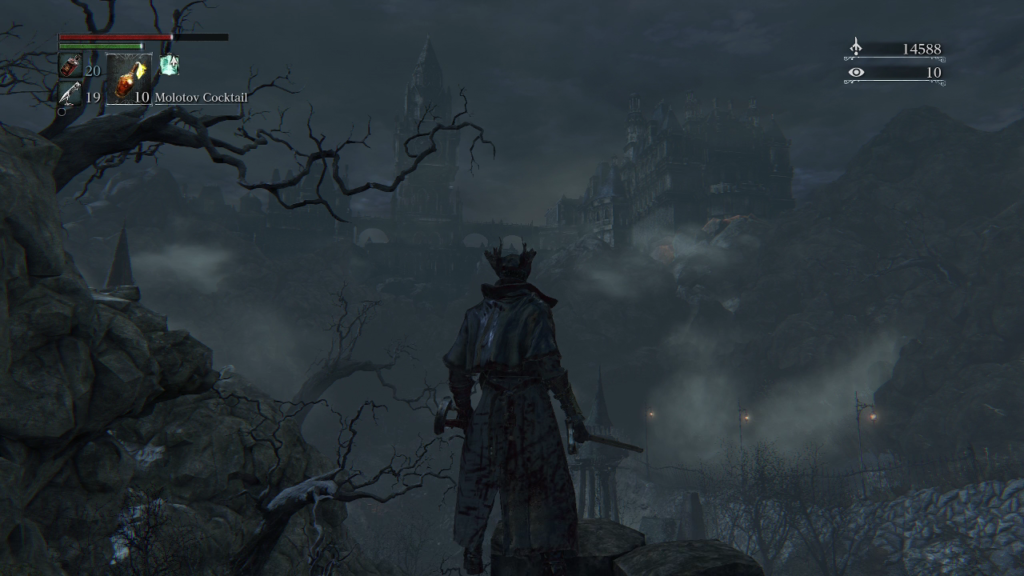
This means if you don’t like Souls, Bloodborne won’t change your mind. The series’ infamous abstruseness is here in full force, and if you found their refusal to clearly state mechanics, plot, destinations, or even goals frustrating, then this will frustrate you too. Whether or not its arcane design is a deliberate choice or an apathetic one is a question of which only the developers know the answer, but I have already endured an excruciating trial-by-fire through the first Dark Souls and found that experience translated into Bloodborne. Yet there are still many differences between the two titles; some I welcome, others I do not.
The most unwelcome change is in healing. The reliable Estus Flask is replaced by Blood Vials, single-use items that drop from slain enemies or may be purchased with Blood Essence, Bloodborne’s primary currency. While otherwise identical to the Estus Flask, Blood Vials’ finitude changes the pacing when I get stuck on a particular section or boss.
When I die in Dark Souls traversing the rooftops of Anor Lando or against the notorious Ornstein and Smough, I can count on the Estus Flask replenishing after I respawn. This system allows me to focus on my current goal. When I die in Bloodborne my supply of Blood Vials does not replenish, forcing me to break away and farm more when I get stuck on a difficult section. The moments I am forced to do this make the already-frustrating experience of repeated death even more grating.
The Blood Vials are wrapped up in the new Rally mechanic. When I take damage, an orange shadow remains on my health meter representing those lost hit points. By striking back against nearby enemies before that shadow fades, I regain some of that health.
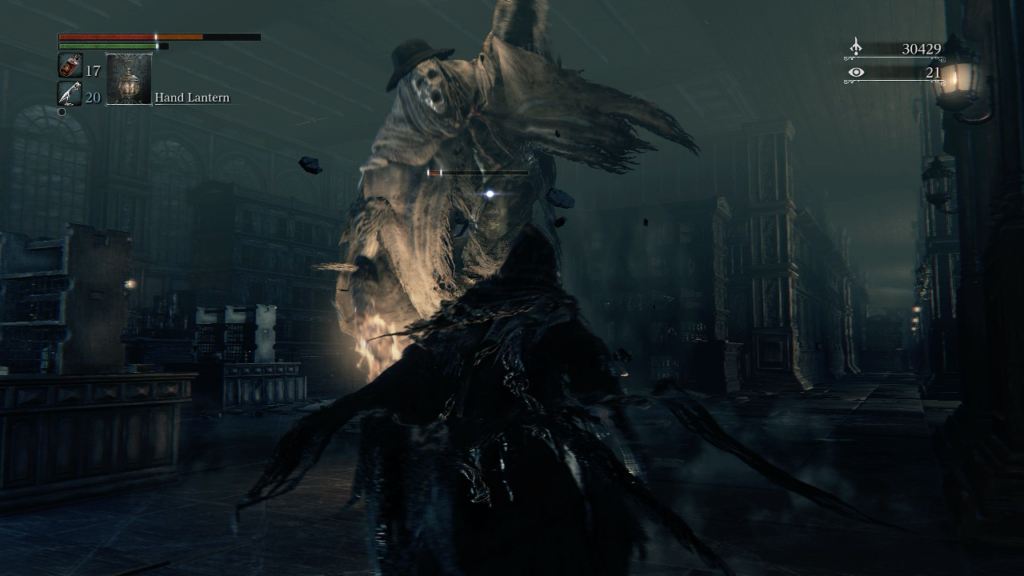
It feels like I am intended to balance liberal Rally offense and conservative Blood Vial quaffing to keep my HP capped. But this is a Souls videogame, meaning even standard enemies can kill me with a few solid hits, to say nothing of bosses; it always feels more prudent to avoid taking damage in the first place and retreat to use a Blood Vial or two when I do get hit. The Rally mechanic only feels relevant when I already have a significant power advantage against my opponent, whaling on weak enemies with no regard for my own safety as I recover what little health I lose.
With the Rally mechanic comes a new focus on aggression. In other Souls entries, shields are common and effective. Bloodborne eschews them, the sole available shield even working in a dig about “engendering passivity” in its description. Instead, I may equip my player character with firearms in their offhand. My initial plan to use a firearm to deal damage from advantageous positions was quickly confounded; their short range and low damage potential limits their use in ranged combat.
Firearms instead are used to interrupt enemies at key moments, leaving them staggered and open for a high-damage Visceral Attack. In typical Souls fashion, there is no prompt to indicate when a firearm blast will stagger an opponent, requiring experimentation to discover those key moments. With patience and effort there’s a rewarding system here that allows a player to devastate enemies with frightening efficiency. Despite this, during my playthrough I quit upgrading my firearms because I took advantage of this system so infrequently it felt like a waste of resources.
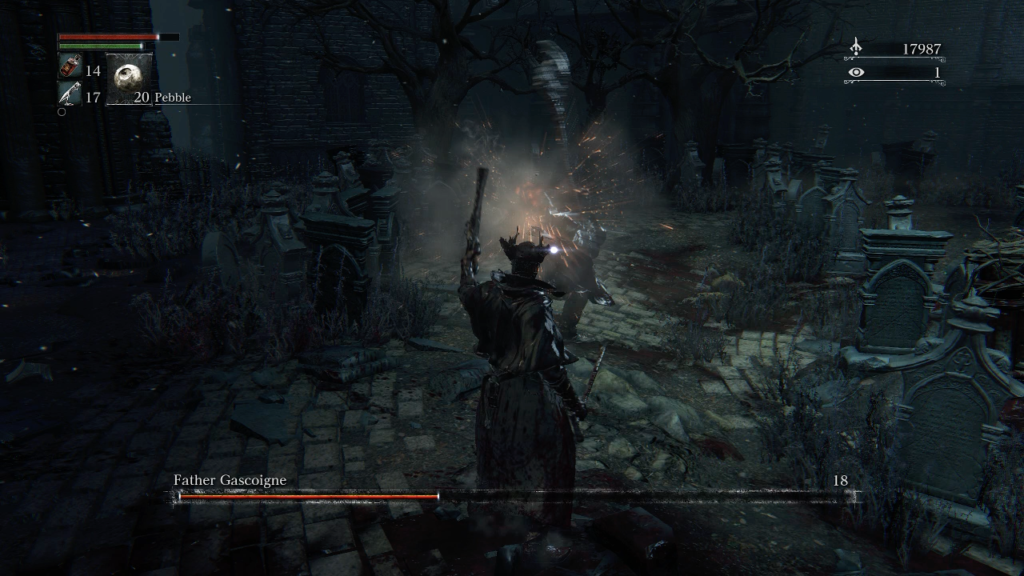
The new Rally mechanic and replacing shields with firearms feels like a plan to disrupt the stamina-heavy, shield-based turtle builds prevalent in the Souls series, and if so then mission accomplished. Combat is transformed from meditative endurance and deliberate probing to frantic dodges and precise strikes. But since caution is needed and mistakes are punished, it still feels like a genuine Souls experience.
Storytelling is a lesser concern in the Souls series, and this holds true for Bloodborne as well. Most of the plot occurs offscreen, away from the player character’s influence and often before they even enter the world. The few non-player characters that don’t immediately try to kill me stand in dark corners, an actor’s bored voice floating from a non-animated face, saying nothing of value. Still more NPCs lurk behind doors and windows, requiring me to check each one to see if anyone is home.
It did not take me long to quit caring about Bloodborne’s NPCs. I quit searching for them, and I quit caring what happened when I found them by accident. This resulted in me missing out on the true final boss, which requires me to interact with an NPC at an early key location. I ran through that place at least a half-dozen times and never saw her, and when I learned of her existence and the doors she opens, I shrugged it off; if Bloodborne doesn’t care enough to make its NPCs visible, I don’t care enough to interact with them. I regret nothing and feel like I missed nothing.
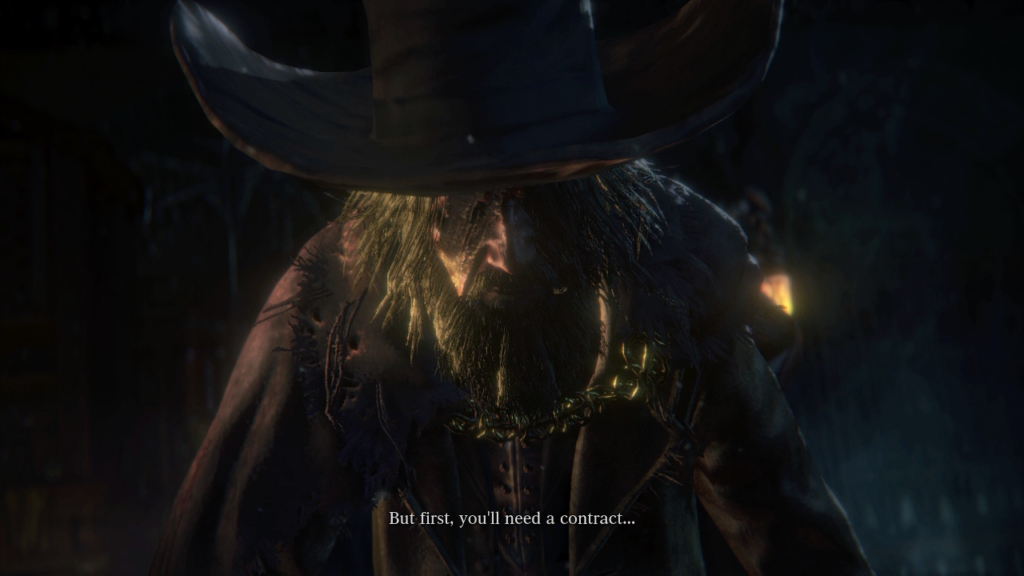
My attitude is reflected by Bloodborne’s plot, such as it is. The opening cutscene lets me know what kind of narrative experience I’m in for: Viewed from a first-person perspective, my player character is strapped to a gurney while an old man tells me “you’ve come to the right place;” what I am in the right place for is never explained. After having me sign a contract (and how I sign a contract while strapped to a gurney is the type of logistical details the Souls series is not concerned with), I am injected with blood. I black out, then wake up to see a bestial man climb from a pool of blood. The wolf-man catches fire and collapses, then tiny emaciated ghouls rise all around me and smother me. After blacking out again, my player character rises from the gurney in a third-person perspective, and the videogame proper begins. This is the extent of in-the-moment storytelling Bloodborne indulges in.
The fact is Bloodborne, and the Souls series as a whole, isn’t interested in telling a story. It has detailed lore buried in item descriptions, message fragments, and inferred from NPC conversations which dedicated fans have assembled, jigsaw-like, into stories we can only assume are correct. These backstories are best enjoyed on wikis and in YouTube videos because the videogame itself revels in how little it cares about contextualizing the player character’s actions with plot. I still enjoyed Bloodborne because its design is otherwise on a level that its lack of a story seems a minor concern, but to listen for years about its amazing plot and then find a videogame with no plot at all is grating.
I have a fraught relationship with the Souls series and its reputation for difficulty. This reputation made my first playthrough of Dark Souls a miserable one as I persevered through difficulty spikes assuming this was the fabled hardness I read so much about. Any one of these encounters could have been made easier by going somewhere else to explore and returning at a higher level with better equipment, a standard strategy in roleplaying videogames. Souls’ reputation caused me to misinterpret clear ludic statements of “you are not ready to be here yet” as “here’s the hard stuff everyone was talking about,” driving my under-leveled Chosen Undead over and over into a meat grinder. Acknowledging that difficulty is always subjective, the Souls series is only hard if your preferred playstyle is to press forward while mashing attack buttons.
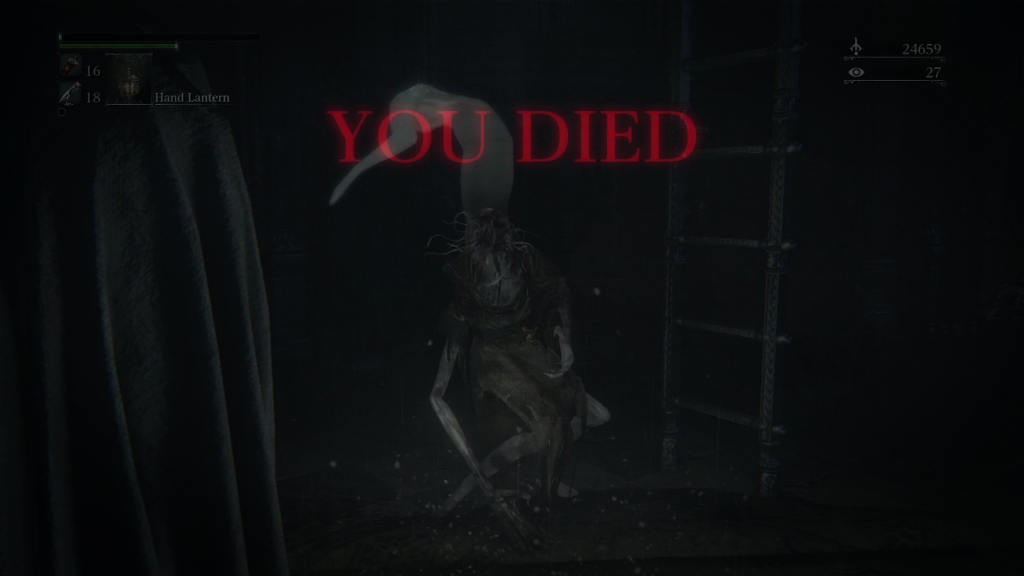
Having previous experience with a Souls series title is a boon for me playing and enjoying Bloodborne; despite new systems affecting health management and combat pacing, it is still governed by the same statistical systems that ground other Souls videogames. Understanding these systems goes a long way towards demystifying its intricacies. Other systems being simplified or stripped away entirely carries Bloodborne further away from Souls’ reputation for inscrutable difficulty. Due to these changes and my previous experience, I found Bloodborne much easier than the first Dark Souls, but not to the extent it felt trivial.
The hardest obstacle I encountered in the first Dark Souls was understanding its equipment systems. At character creation I am presented with a hodgepodge of armor and weapons; better equipment drops randomly and rarely from slain enemies; the upgrade-providing blacksmith is unavailable until after several hours and several bosses, tucked away in a distant tower and requesting use of my precious Souls which I had already been taught were essential for upgrading my character’s stats. Misunderstanding the importance of finding a good weapon and upgrading it, I struggled all the way to Ornstein and Smough using an unupgraded Long Sword, enjoying little of the experience. The biggest, best change Bloodborne brings to the Souls series is streamlining equipment so such mistakes of ignorance are harder to commit.
Bloodborne kicks me out empty-handed to struggle with the afflicted monsters around Iosefka’s Clinic in Central Yharnam, the first area. After punching a few enemies to death, I reach the first Lantern, a checkpoint and fast travel marker. From there I may warp to the Hunter’s Dream, a safe area where a broken old man offers me my first melee weapons and firearms. Right next to him is a desk where I may upgrade them. Minutes into Bloodborne and I have the basics of weapon customization available to me and long before I am able to spend a drop of Blood Essence improving my attributes. By giving me the ability to upgrade my weapons from the outset and putting that mechanic in a centralized base area, Bloodborne communicates the importance of this system in a way the original Dark Souls, with its impersonal blacksmith sequestered in an out-of-the way corner, utterly fails.
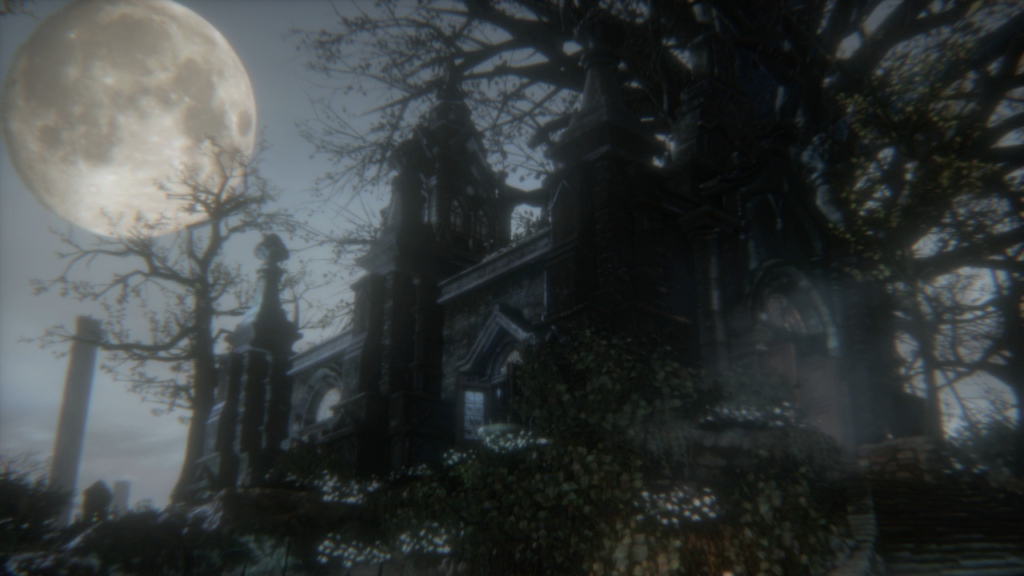
The breadth of weaponry available in Bloodborne is much smaller than Dark Souls, but is more accessible for the same reason. The weapons I do not select on my first visit to the Hunter’s Dream are available right away from a nearby vendor for a small Blood Essence fee. Other weapons are found hidden throughout Yharnam or added to the vendor’s available goods after killing significant enemies, incentivizing and rewarding thorough exploration and judicious slaughter. As weapons feel like rewards for progress and exploration, experimenting with a new weapon feels like less of a labor, and indeed though I tried several new weapons I always returned to my Threaded Cane, the weapon I first chose in the Hunter’s Dream.
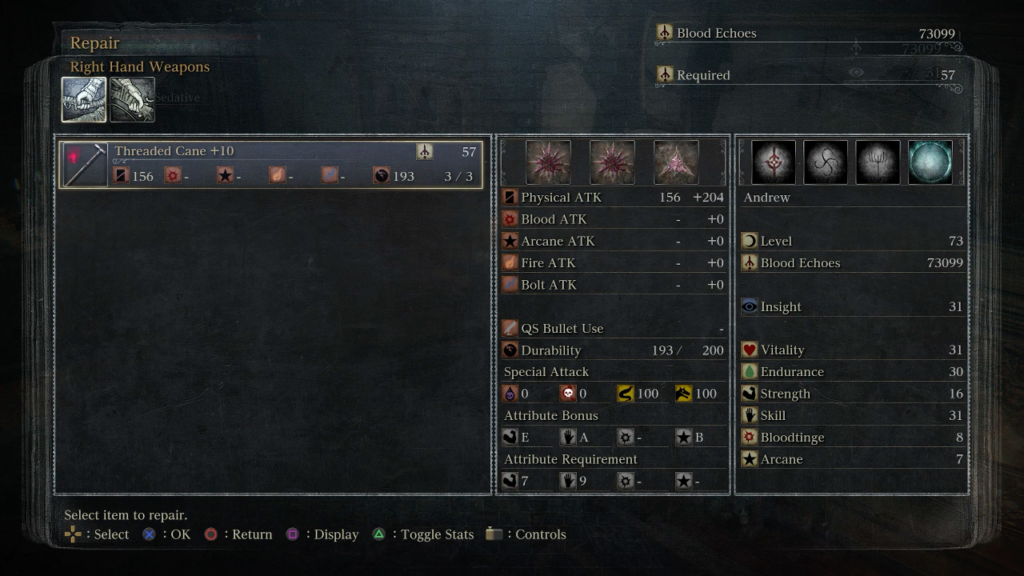
I don’t mean to say that Bloodborne’s systems aren’t still opaque; the way attributes I improve interact with the weapon I am using is still communicated through letters and symbols on a stat sheet rather than explained by a tutorial, requiring inference and experimentation which is the Souls trademark. This is further complicated by how every weapon has an alternate functioning mode which changes how it behaves; my Threaded Cane behaves much like Dark Souls’ Long Sword in its default form, but I may switch to its Alt Form where it becomes a serrated metal whip with a wider range and different damage type but also has limited useability in cramped alleys and suffocating caves. But by simplifying weapons into milestone rewards and centralizing the upgrade table in the Hunter’s Dream, the importance of these systems are made paramount regardless of new complications.
Bloodborne also simplifies one of Souls’ rare resources: Humanity. Humanity’s earliest appearances are complicated for the sake of being complicated, and for me to describe all the systems it interacts with in the first Dark Souls would add another thousand words to this review, so I will not.
Instead, Bloodborne has Insight. Insight behaves a lot like Humanity, but is far less obtrusive. In some ways this makes Insight more arcane—the ways it accumulates seems more arbitrary, the effects it has on the environment seem less clear—but its most common use, activating competitive and cooperative multiplayer activities, are immediately apparent. Its other functions don’t need to be understood as well as Humanity’s for Bloodborne to be an enjoyable experience. If you’re a survivor of the first Dark Souls and its inscrutable Humanity mechanic all you need to know is Bloodborne dispenses with kindling bonfires and is much better for it.
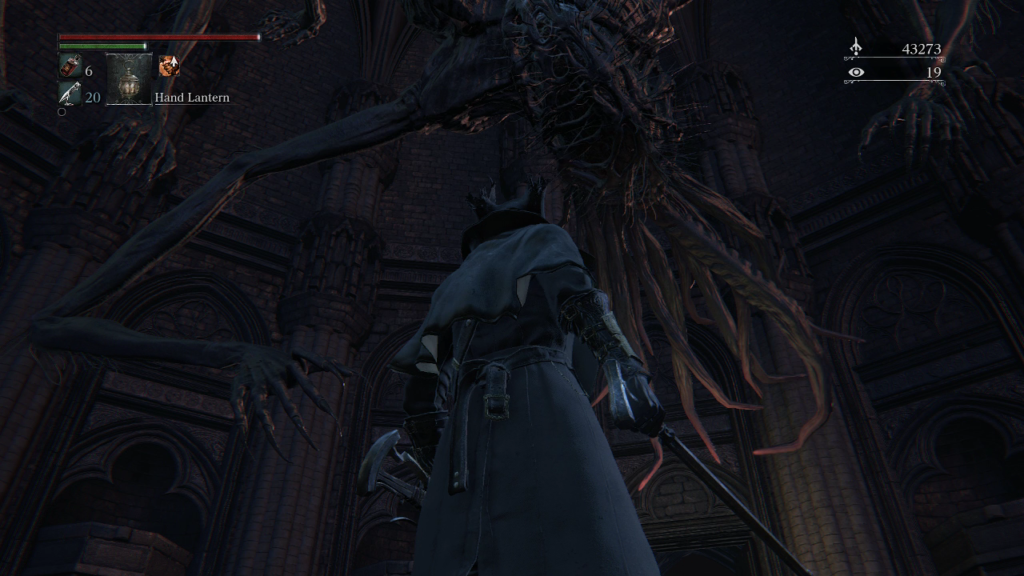
Bloodborne is unmistakably a Souls videogame. It carries over many of the series’ weaknesses: Lifeless characters, directionless scenario design, and dense systems with little to explain them beyond a rudimentary controls tutorial. But for players with the patience to work through them, these weaknesses become strengths. Flush with development experience from the three videogames that precede it, Bloodborne reimagines and refines the Souls formula with new ideas. Not all of these changes work; Blood Vials are the most lamentable, a change brought to a system that wasn’t broken for no other reason than to change it. But other changes are more welcome, cutting down on luck factors and clarifying important systems without sacrificing the iconic abstruseness, forging Bloodborne as an accessible entry-point for Souls newcomers and a refreshing change of pace for veterans.